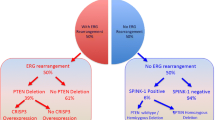Abstract
Few inconclusive studies are reported on ErbB1–ErbB4 overexpression in prostate cancer. The goal of this study is to evaluate ErbB1–ErbB4 nuclear and cytoplasmic expression in prostate cancer patients and to correlate it to the patients’ ethnicity and outcome. T-stage, Gleason score, pre-treatment prostate-specific antigen (PSA) levels and ethnicity were recorded in 50 patients. Ethnicity was defined as either Ashkenazic (immigrated from Europe or North America) or Sephardic origin (Middle East and North Africa). Kattan nomogram was used to predict 5-year progression-free probability (PFP). ErbB1–ErbB4 nuclear and cytoplasmic expression were evaluated by immuno-histochemistry staining. The Ashkenazic (n = 27) and Sephardic (n = 23) patients were comparable in age, T stage, PSA level and Gleason score. ErbB1 cytoplasmic overexpression was found in 66% and none had nuclear overexpression. ErbB2 overexpression was not found in all patients. ErbB3 overexpression was seen in 5%. ErbB4 cytoplasmic and nuclear overexpression was seen in 28% and in 30% to a total of 38%. The ErbB1 and ErbB4 in the Ashkenazic and Sephardic patients were 65, 67, 34 and 44% respectively. PFP of >80%, 60–80% and <60% were seen in 55, 34, and 11% respectively. Ethnicity and overexpression did not significantly contributed to the PFP. In conclusion, ErbB1 and ErbB4 overexpression was seen in 66% and in 38% of prostate cancer patients, while ErbB2 and ErbB3 were almost not overexpressed in prostate cancer patients. Neither overexpression nor ethnicity significantly contributed to the predicted outcome. Further studies on ErbB expression, ethnicity and outcome in prostate cancer patients are warranted.
Similar content being viewed by others
References
Barton J, Blackledge G, Wakeling A et al (2001) Growth factors and their receptors: new targets for prostate cancer therapy. Urology 58:114–122
Di Lorenzo G, Tortora G, D’Armiento FP et al (2002) Expression of epidermal growth factor receptor correlates with disease relapse and progression to androgen-independence in human prostate cancer. Clin Cancer Res 8:3438–3444
Gil-Diez de Medina S, Salomon L, Colombel M et al (1998) Modulation of cytokeratin subtype, EGF receptor, and androgen receptor expression during progression of prostate cancer. Hum Pathol 29:1005–1012
Moul JW, Maygarden SJ, Ware JL et al (1996) Cathepsin D and epidermal growth factor receptor immunohistochemistry does not predict recurrence of prostate cancer in patients undergoing radical prostatectomy. J Urol 155:982–985
Scher HI, Sarkis A, Reuter V et al (1995) Changing pattern of expression of the epidermal growth factor receptor and transforming growth factor alpha in the progression of prostatic neoplasms. Clin Cancer Res 1:545–550
Mellon K, Thompson S, Charlton RG et al (1992) p53,c-erbB-2 and the epidermal growth factor receptor in the benign and malignant prostate. J Urol 147:496–499
Kuhn EJ, Kurnot RA, Sesterhenn IA et al (1993) Expression of the c-erbB-2 (HER-2/neu)oncoprotein in human prostatic carcinoma. J Urol 150:1427–1433
Fossa A, Lilleby W, Fossa SD et al (2002) Independent prognostic significance of HER-2 oncoprotein expression in pN0 prostate cancer undergoing curative radiotherapy. Int J Cancer 99:100–105
Osman I, Scher HI, Drobnjak M et al (2001) HER-2/neu (p185neu)protein expression in the natural or treated history of prostate cancer. Clin Cancer Res 7:2643–2647
Reese DM, Small EJ, Magrane G et al (2001) HER2 protein expression and gene amplification in androgen-independent prostate cancer. Am J Clin Pathol 116:234–239
Signoretti S, Montironi R, Manola J et al (2002) Her-2-neu expression and progression toward androgen independence inhuman prostate cancer. J Natl Cancer Inst 92:1918–1925
Savinainen KJ, Saramaki OR, Linja MJ et al (2002) Expression and gene copy number analysis of ERBB2 oncogene in prostate cancer. Am J Pathol 160:339–445
Hernes E, Fossa SD, Berner AA et al (2004) Expression of the epidermal growth factor receptor family in prostate carcinoma before and during androgen independence. Br J Cancer 90:449–454
Ni CY, Murphy MP, Golde TE et al (2001) Gamma-secretase cleavage and nuclear localization of ErbB-4 receptor tyrosine kinase. Science 294:2179–2181
Lo HW, Xia W, Wei Y et al (2005) Novel prognostic value of nuclear epidermal growth factor receptor in breast cancer. Cancer Res 65:338–348
Rebbeck TR (2005). Genetics, disparities, and prostate cancer. LDI Issue Brief 10:1. http://www.upenn.edu/ldi/issuebrief10_7.pdf. Accessed 19 Nov 2007
Whittemore AS, Cirillo PM, Feldman D et al (2005) Prostate-specific antigen levels in young adulthood predict prostate cancer risk: results from a cohort of Black and White Americans. J Urol 174:872–876
Kattan MW, Zelefsky MJ, Kupelian PA et al (2003) Pretreatment nomogram that predicts 5-year probability of metastasis following three-dimensional conformal radiation therapy for localized prostate cancer. J Clin Oncol 21:4568–4571
Canil CM, Moore MJ, Winquist E et al (2005) Randomized phase II study of two doses of gefitinib in hormone-refractory prostate cancer: a trial of the National Cancer Institute of Canada-Clinical Trials Group. J Clin Oncol 23:455–460
Ziada A, Barqawi A, Glode LM et al (2004) The use of trastuzumab in the treatment of hormone refractory prostate cancer; phase II trial. Prostate 60:332–337
Lara PN Jr, Chee KG, Longmate J et al (2004) Trastuzumab plus docetaxel in HER-2/neu-positive prostate carcinoma: final results from the California Cancer Consortium Screening and Phase II Trial. Cancer 100:2125–2131
Ben-Yosef R, Starr A, Karaush V et al (2007) ErbB-4 may control behavior of prostate cancer cells and serve as a target for molecular therapy. Prostate 67:871–880
Acknowledgements
Esther Eshkol is to be thanked for language editing.
Conflict of interest statement
No funds were received to support this study.
Author information
Authors and Affiliations
Corresponding author
Rights and permissions
About this article
Cite this article
Ben-Yosef, R., Sarid, D., Vexler, A. et al. ErbB1–ErbB4 nuclear and cytoplasmic overexpression, ethnicity and predicted outcome in prostate cancer. Targ Oncol 3, 13–17 (2008). https://doi.org/10.1007/s11523-007-0069-y
Received:
Revised:
Accepted:
Published:
Issue Date:
DOI: https://doi.org/10.1007/s11523-007-0069-y




